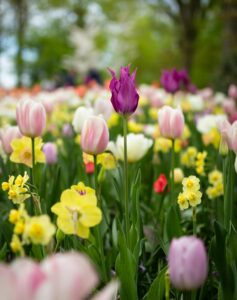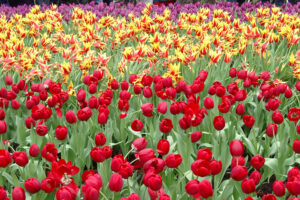The tulip flower (Tulipa) is one of the most beloved and recognizable spring-blooming flowers, known for their vibrant colors, distinctive shapes, and iconic presence in gardens around the world. Tulips have cultural significance and are often associated with the Netherlands, where they have been cultivated since the 17th century. The tulip became a symbol of beauty, luxury, and the Dutch Golden Age.

Tulips are perennial plants that grow from bulbs. Each year, the bulbs produce new shoots and flowers. After flowering, the foliage dies back, and the bulbs go dormant until the next growing season.
Tulips grow from bulbs and produce one or more flower stems, depending on the variety. The stems are usually upright and can vary in height, ranging from short to tall. Tulip plants have strap-like leaves that emerge from the base of the stem. The leaves are typically green but may have a bluish tint in some varieties.
Tulips are cup-shaped flowers with three petals and three sepals, collectively known as tepals. The flowers come in a wide range of shapes, including single, double, fringed, and lily-flowered. Tulips are available in an extensive array of colors, including red, pink, purple, yellow, orange, white, and bi-colors. This diversity allows for stunning displays and creative garden designs.

Tulips are spring-blooming flowers, and their peak flowering period is generally from late March to early May, depending on the region and climate. Keep in mind that tulips are often treated as annuals in warmer climates, where the bulbs may not receive the required chilling period for consistent flowering in subsequent years. In such cases, gardeners may choose to replant new bulbs each fall for continued spring blooms.
Cultivars of Tulip Flowers
There are numerous cultivars of tulip flowers, each with its unique characteristics, including color, shape, size, and blooming time. Here are some popular and noteworthy cultivars of tulips:
‘Apeldoorn’ Series: Includes varieties like ‘Apeldoorn,’ ‘Apeldoorn’s Elite,’ and ‘Apeldoorn’s Sensation.’ They are known for their large, vibrant, and classic tulip-shaped flowers in various colors.
‘Queen of Night’: A stunning single late tulip cultivar known for its deep, velvety maroon to almost black flowers. It adds a dramatic touch to gardens and floral arrangements.
‘Triumph’ Series: This series includes a wide range of cultivars with strong stems and classic tulip forms. Examples include ‘Negrita’ (purple), ‘Gavota’ (red), and ‘Golden Apeldoorn’ (yellow).
‘Darwin Hybrid’ Series: Renowned for their large blooms and strong stems, these tulips come in various colors. ‘Apeldoorn,’ ‘Oxford,’ and ‘Ad Rem’ are popular cultivars in this series.
‘Fringed Elegance’ Series: Features tulips with fringed or serrated edges on the petals, providing a unique and decorative appearance. Examples include ‘Cummins,’ ‘Bastogne,’ and ‘Fringed Maureen.’
‘Lily-Flowered’ Series: Characterized by pointed, reflexed petals resembling a lily. Cultivars in this series include ‘Ballerina’ (orange-red), ‘White Triumphator’ (white), and ‘West Point’ (yellow).
‘Rembrandt’ Tulips: Named after the famous artist, these tulips feature bi-colored or multi-colored petals. While traditional Rembrandt tulips were truly striped, modern cultivars have been developed without the virus that caused the striping.
‘Greigii’ Tulips: Low-growing tulips with mottled or striped foliage. ‘Red Riding Hood’ and ‘Casa Grande’ are examples of cultivars in this series.
‘Kaufmanniana’ Tulips: Also known as waterlily tulips, they have wide, waterlily-shaped flowers that open wide in the sunlight. ‘Stresa’ and ‘Johann Strauss’ are popular cultivars.
‘Double Late’ Tulips: These tulips have fully double blooms, resembling peonies. Cultivars include ‘Angelique’ (pink), ‘Black Hero’ (dark purple), and ‘Mount Tacoma’ (white).
‘Viridiflora’ Tulips: Recognized for their unique green streaks or markings on the petals. ‘Spring Green’ and ‘Greenland’ are popular cultivars in this group.

When selecting tulip cultivars for your garden, consider factors such as bloom time, height, and color to create a diverse and visually appealing display. Additionally, planting a mix of early, mid, and late-season tulips can extend the flowering period in your garden.
Sunlight Requirement of Tulip Flower
Tulip flowers (Tulipa) generally prefer full sunlight for optimal growth and blooming. Tulips thrive when planted in locations that receive full sunlight. Full sun exposure means they should receive at least 6 hours of direct sunlight each day. While tulips can tolerate some light shade, they are less likely to perform at their best in shady conditions. Insufficient sunlight may lead to weak stems, reduced flower production, and elongated growth.
Full sunlight is crucial during the growing season, especially in spring and early summer when tulip bulbs are actively storing energy for the next year’s growth and flowering. In regions with hot climates, partial shade during the hottest part of the day may be beneficial to protect tulips from excessive heat. However, they should still receive sufficient sunlight for the rest of the day.
If planting tulips in containers, place the containers in areas that receive full sunlight. This is particularly important for patio or balcony gardens where sunlight may be limited.
Temperature and Humidity Requirement of Tulip Flowers
Tulip flowers have specific temperature and humidity requirements to thrive and produce healthy blooms. Tulips require winter chilling to initiate flowering. This chilling period simulates winter conditions and is necessary for the development of flower buds. Tulip bulbs are typically planted in the fall to provide them with this required chilling period.
Tulips are adapted to cool to cold climates. They perform well in regions with distinct seasons, where winters are cold enough to fulfill their chilling requirement. Tulips are hardy in USDA Hardiness Zones 3 to 8, although specific varieties may have different hardiness ranges. The different zones represent the average minimum winter temperatures in a given region.

Tulips grow best when temperatures range between 50°F to 60°F (10°C to 15°C) during their active growing season in spring. Warmer temperatures during this period contribute to robust flowering. While tulips can tolerate cool temperatures, they are less tolerant of extreme heat. In regions with hot climates, planting tulips in partial shade or providing afternoon shade can help protect them from excessive heat.
Tulips generally prefer moderate humidity levels. They are adaptable to a range of humidity conditions, but excessive humidity, especially in combination with high temperatures, may increase the risk of diseases such as botrytis.
Soil Requirement of Tulip Flower
Loamy soil, which has a balanced mix of sand, silt, and clay, is ideal for tulips. This type of soil provides good drainage while retaining enough moisture for the bulbs to establish roots. Tulips thrive in slightly acidic to neutral soil with a pH range of 6.0 to 7.0. Tulips prefer well-draining soil to prevent waterlogging, which can lead to bulb rot and other fungal issues. Heavy or compacted soil that retains water is not suitable for tulips.
Prepare the soil by loosening it to a depth of 12 to 15 inches (30 to 38 cm) before planting tulip bulbs. This aids in root development and allows the bulbs to settle comfortably in the soil.

Propagation of Tulip Flower
Tulips are commonly propagated by planting new bulbs, and this method is one of the most straightforward ways to introduce tulips into your garden.
Buy tulip bulbs from reputable nurseries or garden centers. Choose high-quality bulbs with no signs of damage or disease. Consider the bloom time, height, and color of the tulip varieties you prefer.

Choose a location with full sunlight for your tulips. Ensure that the soil is well-draining and slightly acidic to neutral.
Plant the tulip bulbs at the recommended depth, which is typically around 6 to 8 inches (15 to 20 cm) deep. The general rule is to plant them at a depth three times the height of the bulb.
Space the bulbs according to the specific recommendations for the tulip variety you are planting. Typically, tulips are planted a few inches apart.
Plant the bulbs with the pointed end facing upwards. This is where the shoot will emerge.
After planting, water the area thoroughly to settle the soil and initiate root development. Ensure that the soil remains consistently moist but not waterlogged.
Apply a layer of organic mulch, such as straw or shredded bark, around the planted bulbs. Mulching helps retain soil moisture, suppress weeds, and provide insulation.
By following these steps, you can successfully propagate tulips through newly purchased bulbs.
Winter Care of Tulip Plant
Providing proper winter care for tulip plants when grown as perennials is essential to ensure their health and promote consistent flowering in subsequent years.
Apply a layer of organic mulch, such as straw or shredded leaves, around the base of the tulip plants after the soil has frozen. Mulch helps insulate the soil, protecting the bulbs from extreme temperature fluctuations and frost heaving.
Ensure that the tulip plants receive adequate moisture before the ground freezes. Well-hydrated bulbs are more resilient to winter stress. However, avoid overwatering, as waterlogged soil can lead to bulb rot.
Allow the foliage of the tulip plants to die back naturally after blooming. The dying foliage helps the bulbs store energy for the next growing season. Do not cut the foliage until it has turned yellow and started to wither.
In regions with extremely cold winters, consider adding an extra layer of mulch or using other protective coverings to shield the tulip plants from severe weather conditions.
Choose tulip varieties that are well-suited for your USDA hardiness zone. Some tulip varieties are more cold-hardy than others, and selecting the right ones for your climate can enhance their chances of surviving winter.
In areas where rodents are active during winter, consider protecting tulip bulbs from nibbling by using wire mesh or other physical barriers. Rodents may find tulip bulbs attractive, and their feeding can damage the bulbs.
Water Requirement of Tulip Flower
Tulips require consistent moisture, but they don’t tolerate waterlogged soil. Water the plants regularly, keeping the soil evenly moist, especially during the growing season in spring. Overwatering can be harmful to tulips. Avoid excessive irrigation that leads to soggy soil. Allow the top inch (2.5 cm) of soil to dry out between watering sessions. Water tulips in the morning to allow the foliage to dry before evening. Moist foliage overnight can increase the risk of fungal diseases.
When you water, provide a deep soak rather than shallow, frequent watering. Deep watering encourages the development of a robust root system. Once tulips have finished blooming and the foliage begins to yellow and wither, reduce watering. This signals the plant to enter dormancy.
If growing tulips in containers, monitor the moisture level more closely, as containers can dry out faster than garden beds. Ensure that containers have drainage holes to prevent waterlogging.

Fertilizer requirement
Before planting tulip bulbs, incorporate well-rotted compost or aged manure into the soil. This helps improve soil structure and provides some initial nutrients for the bulbs. Mix a balanced, slow-release fertilizer into the soil at the time of planting. Choose a fertilizer with equal amounts of nitrogen (N), phosphorus (P), and potassium (K), or a formulation specifically designed for bulbs. Follow the recommended application rates on the fertilizer package.
Apply fertilizer when tulip shoots begin to emerge and continue until the plants start to bloom. This is the period when tulips benefit most from additional nutrients. Avoid using fertilizers high in nitrogen, especially after blooming. High-nitrogen fertilizers can promote excessive foliage growth at the expense of flower development. Stop fertilizing tulips once they have finished blooming and the foliage begins to yellow and wither.
If growing tulips in containers, use a well-balanced, slow-release fertilizer at the beginning of the growing season. Container plants may benefit from a more controlled release of nutrients over time.
Problems While Growing Tulip Flower
While tulips are generally hardy and easy to grow, they can face certain problems that may affect their health and blooming.
Fungal Diseases:
Botrytis Blight: A fungal disease that causes brown spots on the leaves and flowers. Provide good air circulation, avoid overhead watering, and remove infected plant material.
Pests:
Aphids: These small, sap-sucking insects can distort new growth and transmit diseases. Use insecticidal soap or neem oil to control aphids.
Thrips: Thrips feed on tulip flowers, causing silvery streaks and deformed petals. Insecticidal soap or neem oil can help manage thrip infestations.
Rodent Damage: Rodents may dig up tulip bulbs for food. Use protective measures like wire mesh or planting bulbs in bulb cages to deter rodents.
Deer and Other Wildlife: Deer finds tulip foliage and flowers attractive. Consider using deer-resistant plants in combination with tulips or applying deer repellents to protect your garden.
Viral Diseases: Tulip Breaking Virus, causes color breaking in tulip petals, resulting in streaks or flames of a different color. Infected bulbs should be removed to prevent the spread of the virus.
Weather-Related Issues: Late spring frosts can damage emerging tulip buds. Planting tulips in well-drained soil and providing adequate mulch may help mitigate frost damage. Alternating freezing and thawing can cause bulbs to be pushed out of the soil. Replant heaved bulbs promptly.
Poor Blooming: In warmer climates, tulips may not receive the necessary chilling hours, leading to poor blooming. Choose varieties suitable for your climate.
Improper Planting Depth: Planting tulip bulbs too shallow can expose them to temperature extremes. Follow recommended planting depths to protect bulbs.
Tulip Fire: Botrytis tulipae is a fungal disease that causes brown lesions on the leaves, leading to wilting and decay. Infected plants should be removed, and fungicides may be used preventatively.
Ornamental Uses of Tulip Flowers
Tulip flowers are highly valued for their ornamental beauty and are widely used in various landscaping and decorative settings. Here are some common ornamental uses of tulip flowers:
Garden Beds and Borders: Tulips are popular choices for garden beds and borders, creating vibrant displays of color in spring. They can be planted in groups or mixed with other spring-blooming bulbs and perennials.

Mass Plantings: Large groups of tulips are planted together to create stunning masses of color, making a bold visual impact in gardens and public spaces.
Rock Gardens: Dwarf and early-blooming tulip varieties are well-suited for rock gardens, adding pops of color to these unique landscapes.
Containers and Pots: Tulips thrive in containers, making them ideal for balcony gardens, patios, and other small spaces. Container plantings can be easily moved for different effects.

Cut Flower Arrangements: Tulips are classic cut flowers, often used in floral arrangements. They add elegance and simplicity to bouquets and are available in a wide range of colors.

Indoor Flower Displays: Potted tulips can be forced to bloom indoors during the winter, bringing early spring color to homes. These potted tulips are often used as decorative centerpieces.

Public Gardens and Parks: Many public gardens and parks feature extensive displays of tulips, creating breathtaking landscapes during the spring season.

Formal Landscapes: Tulips can be used in formal garden designs, adding a touch of sophistication with their upright stems and colorful blooms.
Mixed Borders: Combine tulips with other spring-blooming flowers and perennials to create mixed borders that provide interest and variety.

Naturalized Areas: In more informal settings, tulips can be naturalized in grassy areas, creating a more relaxed and natural appearance.
Special Events and Celebrations: Tulips are often used for special events, such as weddings, anniversaries, and celebrations, where their vibrant colors symbolize joy and love.
Public Installations: Tulips are sometimes featured in large public art installations, creating temporary displays that captivate audiences.
Historical Gardens: Tulips have historical significance, and they are often included in gardens that aim to recreate specific periods or styles.
Symbolic Plantings: Tulips are symbolic flowers associated with love and spring. People often plant them to express affection or celebrate the arrival of the spring season.

Tulips’ versatility and wide range of colors make them a favorite choice for various ornamental purposes, adding beauty and charm to diverse landscapes and events.


